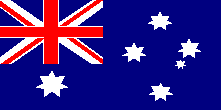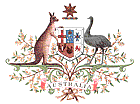
The Commonwealth of Australia Constitution Act was finalized on 9th July 1900. The Oath that all Australians swear by is ;- "I, A.B., do swear that I will be faithful and bear true allegiance to Her Majesty Queen Victoria, Her heirs and successors according to law. SO HELP ME GOD!"

The Australian Coat of Arms ( pictured above ) has a kangaroo and an emu holding a shield. There is a star and every point stands for a state. At the bottom there is a sign that says Australia. There are pictures on the shield and they are as follows. A ribbon under the star. It is blue and yellow. The wattle branch. Australia's present coat of arms was granted in 1912 by King George V of England. The Australian coat of arms has 12 corners and 12 edges and 14 faces.
Advance Australia Fair was proclaimed as our national anthem after exhaustive surveys of national opinion. It was first performed on November 31st 1878 in Sydney. In 1974 the Australian Bureau of Statistics conducted a national opinion poll of 60,000. January 1976 God Save the Queen was reinstated as the National Anthem. It made Australia the only country to have a choice of four National Anthems. It was decided that God Save the Queen was to be played at all royal and vice-regal occasions and the remaining three, Advance Australia Fair, Waltzing Matilda and Song of Australia could be used on all other occasions. Then in May Australian's went back to the polls and voted that Advance Australia Fair was to be played at all other occasions. This was once again changed in 1984 to allow God Save the Queen to be played only when a Royal family member was present.
Australians all let us rejoice,
For we are young and free;
We’ve golden soil and wealth for toil;
Our home is girt by sea;
Our land abounds in nature’s gifts
Of beauty rich and rare;
In history’s page, let every stage
Advance Australia Fair.
In joyful strains then let us sing;
Advance Australia Fair.
Beneath our radiant Southern Cross
We’ll toil with hearts and hands;
To make this Commonwealth of ours
Renowned of all the lands;
For those who’ve come across the seas
We’ve boundless plains to share;
With courage let us all combine
To Advance Australia Fair.
In joyful strains then let us sing,
Advance Australia Fair.
Australia has had its fair share of bush rangers and robbers but none so famous as Ned Kelly and his gang. Ned Kelly was shot and captured on 28th June 1880 after a dramatic three day siege in which he held hostages. He released the women and children one by one after more than thirty police officers surrounded the building. Police then waited for movement by the gang but only one man attacked them from the rear in a long overcoat and iron mask. Police realised after there shots at him were having no effect he had to be wearing some sort of armour plate. They then shot at his legs which toppled him. As he fell he yelled "I am done, I am done".
Australian's have served in the armed forces and fought to defend our land and heritage. In August 1914 Australia declared it would join England in defending Australia's shores. Then in November HMAS Sydney sunk the German warship Emden near Cocas Island after it destroyed numerous ships.
On 25 April 1915 Australia was once again at war. With the Allies (Britain, France and Russia, Italy, Japan, and the USA joining in 1917), Australia was fighting against the Central Powers (Germany, Turkey and Austria-Hungary). In response to a request for help from Russia, which was being battered by the Turks in the Caucasus, the Allies decided to begin a campaign which they hoped would distract Turkey from their attack on Russia. The plan was for the Allies to attack and take the Gallipoli Peninsula, on Turkey's Aegean coast, from which point the Allies believed they could take control of the Dardanelles - a 67 kilometer (42 mile) strait which connects the Aegean Sea with the Sea of Marmara - and lay seige to Turkey's main city, Istanbul (then Constantinople). As part of the larger British Empire contingent, Australian troops were brought in from training in Egypt to participate. On April 25, 1915, the Australian troops landed on the Gallipoli Peninsula. Instead of finding the flat beach they expected, they found they had been landed at the incorrect position and faced steep cliffs and constant barrages of enemy fire and shelling. Around 20,000 soldiers landed on the beach over the next two days to face a well organised, well armed, large Turkish force determined to defend their country - and led by Mustafa Kemal, who later became Attaturk, the leader of modern Turkey. Thousands of Australian men died in the hours that followed the landing at that, the wrong beach. That beach would eventually come to be known as Anzac Cove.
What followed the landing at Gallipoli is a story of courage and endurance, of death, and despair, of poor leadership from London, and unsuccessful strategies. The Australian soldiers and the Turks dug in - literally - digging kilometres of trenches, and pinned down each other's forces with sniper fire and shelling. Pinned down with their backs to the water the Australians were unable to make much headway against the home-country force. Eventually it was decided that the Allied troops would be withdrawn from the Peninsula; the attempt to control the Dardanelles had failed. The ANZACs were evacuated with a huge lose of 7600 men and returned to the Middle East and the Western Front where they were involved in other battles.The Gallipoli campaign was an enormous failure, and the failure led to the resignation of senior politicians in London. Thousands of Australian and New Zealand soldiers had died, and thousands of other Allied troops from France and Britain also died.
In remembrance of these soldiers Australian's now commemorate Anzac Day on the 25th of April each year with full parades, services and prayers for the lost soldiers. This is one of Australia's sacred days.
Remembrance Day, the 11th hour of the 11th day of the 11th month marks the end of the Great War 1918, London, UK. Austalian soldiers danced down the streets as Armistice Day marked the end of the bloodiest war the world had seen.Although Australia became a nation in 1901 its loyalties still lay with Britain and so the Australian government had committed itself to supporting the British war effort and Australian men volunteered to fight and die on the battlefields of Europe, Turkey and the Middle East. Of the Australian population of 5 million, 300,000 young men went to the Great War. Of those 60,000 died and 156,000 were wounded or taken prisoner.
The the second World War started in 1940 and once again Australian's aided Britian. Darwin was bombed in February 1942 by the Japanese killing more than 200 people. This war finished in 1945.
![]()
![]()
![]()
![]()
![]()
![]()
![]()
Tasmania Northern Territory Australian Capital Territory Queensland

